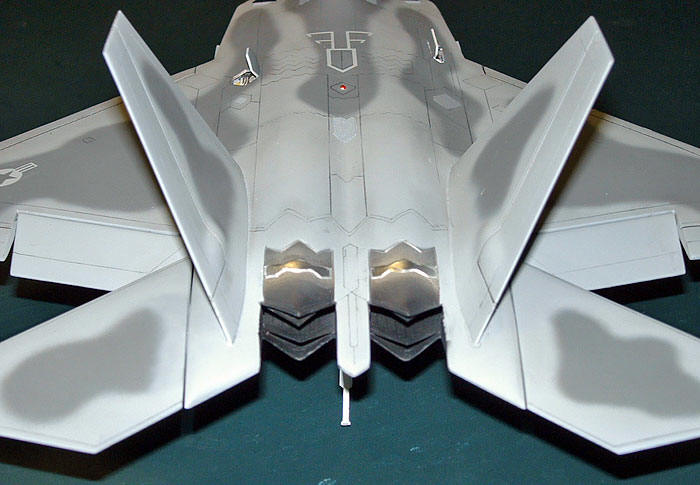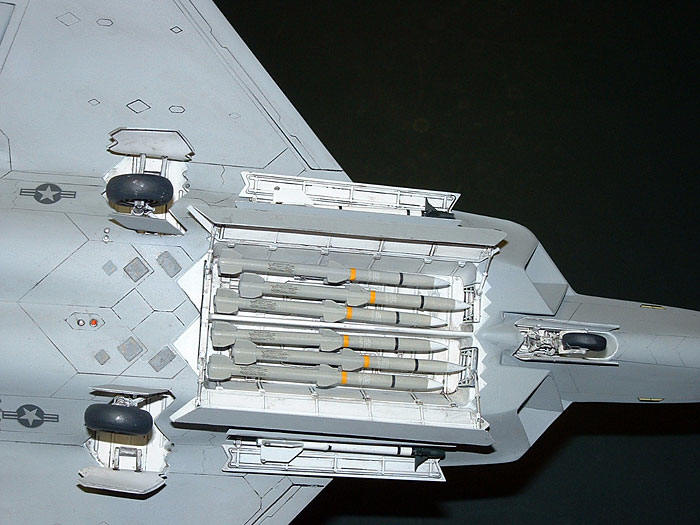|
F/A-22 Raptor
by
Christopher J. Bowie
|
 |
|
F/A-22 Raptor |

available online from Squadron.com
The F/A-22 Raptor is the most advanced fighter aircraft in the world
today, combining stealth, high maneuverability, “supercruise”
capability, advanced avionics, and powerful sensors into a single lethal
fighting machine.
Kits first appeared in 1/32nd scale and 1/72nd scale,
but it was not until a few years ago that Italeri produced a 1/48 scale
version.
This is my third Raptor based on this kit. One graces
the desk of the Director of Operations for Pacific Air Forces, the other
the side table of the USAF’s Chief of Staff. This is an excellent kit
with the exception of a very weak interior. To improve this, I used the
Eduard photo-etched detail set and a resin Cutting Edge Aces II ejection
seat.
The use of the Eduard detail set does require one major modification—you
need to chop the top off the hump that fits over the instrument panel
and create a new plastic “hump” to hold the photo-etched instrument
panel. I built my “hump” out of sheet plastic, which was then sanded
down and smoothed using putty. But this is fairly minor surgery that
brings a huge improvement in appearance using the photo-etched panels
and the printed sheet that simulates the displays.

One key technique to painting the instrument panels is to first spray
them with gloss black or dark gray enamel and let dry. Then put a wash
of acrylic white on the panels and let dry. Rub off the excess with a
Q-tip dipped in window cleaner (like Windex). The Windex wipes off the
white paint, which stays in the indentations (representing the buttons),
but won’t take off the enamel. The kit seat is pretty weak and I
replaced it with a modified resin Aces II seat. Look on Lockheed’s
F/A-22 web site for lots of photos of the interior and exterior.
The kit goes together fairly easily with the exception of the top two
fuselage pieces, which feature a seam than runs sideways across the
middle of the fuselage. Unfortunately, this seam is very apparent and
needs to be dealt with. On all three kits that I have built, I have been
unable to get the two parts to fit together tightly, even after much
sanding and fiddling—I always got a dip that just didn’t look right. To
fix this, I first superglued the parts together, masked off the area on
either side of the seam (to reduce the detail that would be lost) and
then laid a thin layer of putty over the seam to fill in the dip. When
this dried, I sanded it off using a stiff standing stick. I then sprayed
with primer and filled and sanded as required. I then re-etched the
panel lines covered by the putty using my X-acto knife.

The other problem area is the intakes—specifically, there is no interior
intake trunking on the top of the intakes. If this bothers you, you can
make intake covers out of plastic (or build the interior trunking). On
this model, I didn’t bother.
The model has lots of panels that open (since it is a stealthy aircraft,
the exterior surface must be kept smooth), which makes for an
interesting display. Two opening panels on the top (probably to increase
air flow to the engines during ground operations) can be displayed open,
as can the doors over the gun, the auxiliary power unit, the four weapon
bays, and the tail hook. I find it interesting that the tail hook
requires its own assembly of doors and gears to keep the F/A-22
stealthy. The latter is nicely represented on the kit.
The Eduard kit provides photo-etched mesh grill for the various openings
on the surface, which really improve the look of the kit. The engine
burner cans have very interesting shapes (diamonds) compared to other
jet fighters (round tubes).
 I
painted the aircraft Polly S light ghost grey overall and the camouflage
pattern using Tamiya dark sea grey (both paints thinned 50:50 with
rubbing alcohol). I then masked off the various openings and sprayed
these gloss white. When dry, I sealed the whole model with Testor’s
Metalizer Sealer to prepare for decaling. I then masked off and painted
the engine areas using various shades of metalizer. After decaling (the
kit decals are thin and opaque), I applied Bare Metal foil to the center
section of the afterburner section. I
painted the aircraft Polly S light ghost grey overall and the camouflage
pattern using Tamiya dark sea grey (both paints thinned 50:50 with
rubbing alcohol). I then masked off the various openings and sprayed
these gloss white. When dry, I sealed the whole model with Testor’s
Metalizer Sealer to prepare for decaling. I then masked off and painted
the engine areas using various shades of metalizer. After decaling (the
kit decals are thin and opaque), I applied Bare Metal foil to the center
section of the afterburner section.
On most models, I put a wash of dark grey and black acrylic paint
thinned with water (and a drop or two of dish soap) on the panel lines,
let dry, and then remove the excess using a Q-tip dipped in Windex. The
metalizer sealer prevents the Windex from removing the acrylic paint.
The panel lines in the model are so light, however, that I could not use
this technique; the Windex would remove the paint from the panel lines
as well. Accordingly, I just used a sharpened No. 2 pencil to accent the
panel lines—if I made a mistake, a quick rub with a dampened finger took
off the excess. The dark grey of the pencil had just the right accent of
color for the exterior grey of the aircraft. With this done, I put on a
coat of flat Poly S clear. After application, I used a Q-tip to remove
the flat coat from the baremetal foil section on the engines, which
gives these areas a little more sheen.

In the various openings, I applied a dark grey acrylic wash to bring out
the detail in the various bays. Final assembly of the model takes a
little more time than usual due to the multiplicity of opening panels. I
detailed the Sidewinders held in the side bays by adding a railroad
jewel to the front with superglue; this makes the missiles really look
like they have infrared seekers.
All in all, this is a very nice kit of a very swoopy
looking airplane.
The F/A-22 will enter service in the next few years—and
I’m sure we’ll see even better kits in quarter scale. But for now, this
is the only game in town.
I’m going to keep this one on my desk!
Text, Models and Images Copyright © 2004 by
Chris Bowie
Page Created 22 December, 2004
Last Updated
22 December, 2004
Back to
HyperScale Main Page |
Home
| What's New |
Features |
Gallery |
Reviews |
Reference |
Forum |
Search